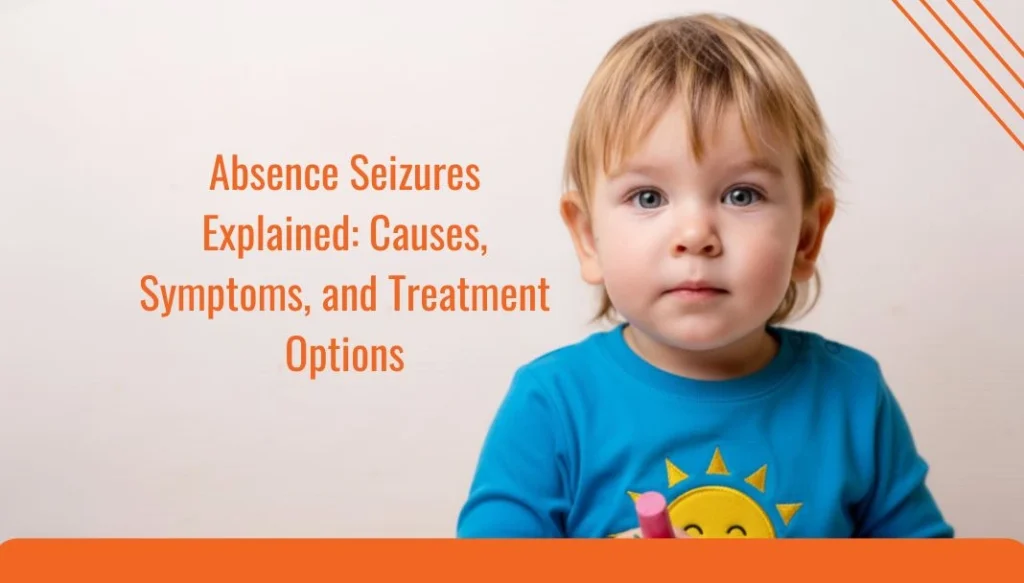Have you ever noticed someone staring blankly for a few seconds, unresponsive to their surroundings?
This could be an absence seizure, also called a petit mal seizure. These brief episodes of impaired consciousness can disrupt learning, work, and daily activities. While they are often mild, frequent seizures require medical attention to prevent complications.
In this blog, we’ll explore the causes, symptoms, and treatment options for absence seizures.
Understanding absence seizures
Absence seizures are a form of generalised seizure that affects brain activity, leading to short, sudden lapses in awareness.
Unlike convulsive seizures, absence seizures do not cause physical shaking but may result in blank staring, subtle body movements, or unresponsiveness for a few seconds.
These are sometimes referred to as silent seizures in babies because they can be difficult to detect.
Absence seizures symptoms

During an absence seizure, a child may briefly lose awareness, staring into space without responding to their surroundings.
Since these seizures are usually brief—lasting 30 seconds or less—parents or teachers might overlook them or mistake them for daydreaming.
- Brief, sudden staring spell or “blank stare”
- Occasional fluttering of the eyelid or nodding of the head
- Loss of awareness
- Complete stop in activity during the seizure
- Chewing, even if there is nothing in the mouth
- Brief interruptions in speech or activity
Children with absence seizures may experience multiple episodes daily without even noticing. These seizures often present with subtle signs like rapid blinking, eyelid fluttering, eye-rolling, or lip-smacking, making them easy to miss.
What triggers absence seizures in children?
Triggers are things in your environment that can cause symptoms to happen. Triggers of absence seizures may include:
- Bright, flashing lights
- Breathing deeply and fast (hyperventilating)
- Sleep deprivation
- Stress and anxiety
- Skipping meals
Are absence seizures dangerous?
While absence seizures are not typically harmful, they can impact a child’s ability to focus in school and engage in daily activities.
If left untreated, they may increase the risk of developing other seizure disorders later in life.
Diagnosis of absence seizures
If your child shows signs of absence seizures, they should see a paediatrician for an evaluation. The doctor may suggest an EEG (electroencephalogram), a test that records brain activity, to confirm the diagnosis. In children with absence epilepsy, the EEG will show a specific pattern called ‘spike and wave’ activity during a seizure.
To help trigger a seizure during the test, the doctor may ask your child to breathe deeply and quickly (hyperventilate) for a few minutes. Since hyperventilation causes an absence seizure in most children, it can be useful in making a diagnosis.
In most cases, an EEG is enough to diagnose absence seizures. However, if the seizures continue despite treatment or the diagnosis is unclear, the doctor may suggest additional tests like an MRI scan to check brain structure or genetic tests for further evaluation.
Absence seizures treatments
Managing absence seizures involves a combination of medications, lifestyle adjustments, and, in some cases, dietary changes. Early treatment is essential to prevent seizures from interfering with a child’s daily life and development.
Medications:
Doctors typically prescribe antiepileptic medications like ethosuximide, sodium valproate, and lamotrigine to help control absence seizures.
Treatment typically begins with a low-dose medication, which is gradually increased until the seizures are effectively managed. Regular follow-ups with a doctor are essential to track progress and make any necessary adjustments to the treatment plan.
Lifestyle modifications:
Certain lifestyle changes can help minimise the frequency of absence seizures:
- Maintaining a regular sleep schedule – Insufficient sleep can increase seizure activity.
- Managing stress – Stress and anxiety can trigger seizures, so relaxation techniques and structured routines can be beneficial.
- Avoiding triggers – If flashing lights or hyperventilation trigger seizures, limiting exposure may help.
Ketogenic diet:
In some cases, a ketogenic diet (high-fat, low-carb) may help reduce seizures, especially in children who do not respond well to medication.
This diet should be followed under medical supervision.
Visit Neuropedia for absence seizures management in Dubai
If your child frequently experiences staring spells, unresponsiveness, or other symptoms of absence seizures, early diagnosis and treatment are essential for their well-being.
At Neuropedia, the first comprehensive pediatric neurosciences centre in Dubai, we offer world-class expertise in neurology, psychology, behavioural sciences, and rehabilitative care. Our team of specialists is committed to providing accurate diagnoses and personalised treatment plans to help children manage absence seizures effectively.











 04 343 1113
04 343 1113 info@neuropedia.ae
info@neuropedia.ae







.png)







